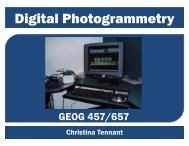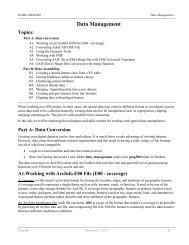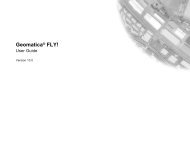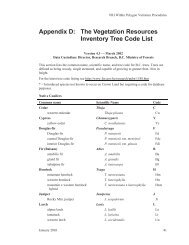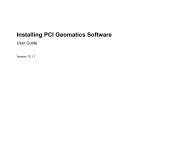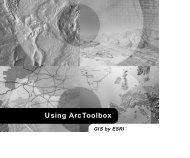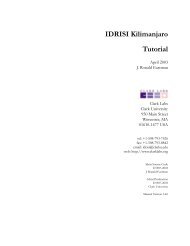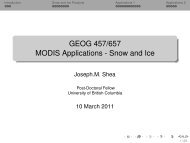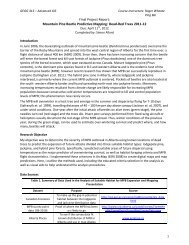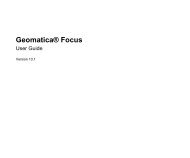Understanding Map Projections
Understanding Map Projections
Understanding Map Projections
Create successful ePaper yourself
Turn your PDF publications into a flip-book with our unique Google optimized e-Paper software.
MOLLWEIDE<br />
Distance<br />
Scale is true along latitudes 40°44' N and S.<br />
Distortion increases with distance from these lines<br />
and becomes severe at the edges of the projection.<br />
LIMITATIONS<br />
Useful only as a world map.<br />
The central meridian is 65° E.<br />
DESCRIPTION<br />
Also called Babinet, Elliptical, Homolographic, or<br />
Homalographic.<br />
USES AND APPLICATIONS<br />
Suitable for thematic or distribution mapping of the<br />
entire world, frequently in interrupted form.<br />
Combined with the Sinusoidal to create Goode’s<br />
Homolosine and Boggs.<br />
Carl B. Mollweide created this pseudocylindrical<br />
projection in 1805. It is an equal-area projection<br />
designed for small-scale maps.<br />
PROJECTION METHOD<br />
Pseudocylindrical equal-area projection. All parallels<br />
are straight lines, and all meridians are equally<br />
spaced elliptical arcs. The exception is the central<br />
meridian, which is a straight line. The poles are<br />
points.<br />
LINEAR GRATICULES<br />
The equator and central meridian.<br />
PROPERTIES<br />
Shape<br />
Shape is not distorted at the intersection of the<br />
central meridian and latitudes 40°44' N and S.<br />
Distortion increases outward from these points and<br />
becomes severe at the edges of the projection.<br />
Area<br />
Equal area.<br />
Direction<br />
Local angles are true only at the intersection of the<br />
central meridian and latitudes 40°44' N and S.<br />
Direction is distorted elsewhere.<br />
72 • <strong>Understanding</strong> <strong>Map</strong> <strong>Projections</strong>



